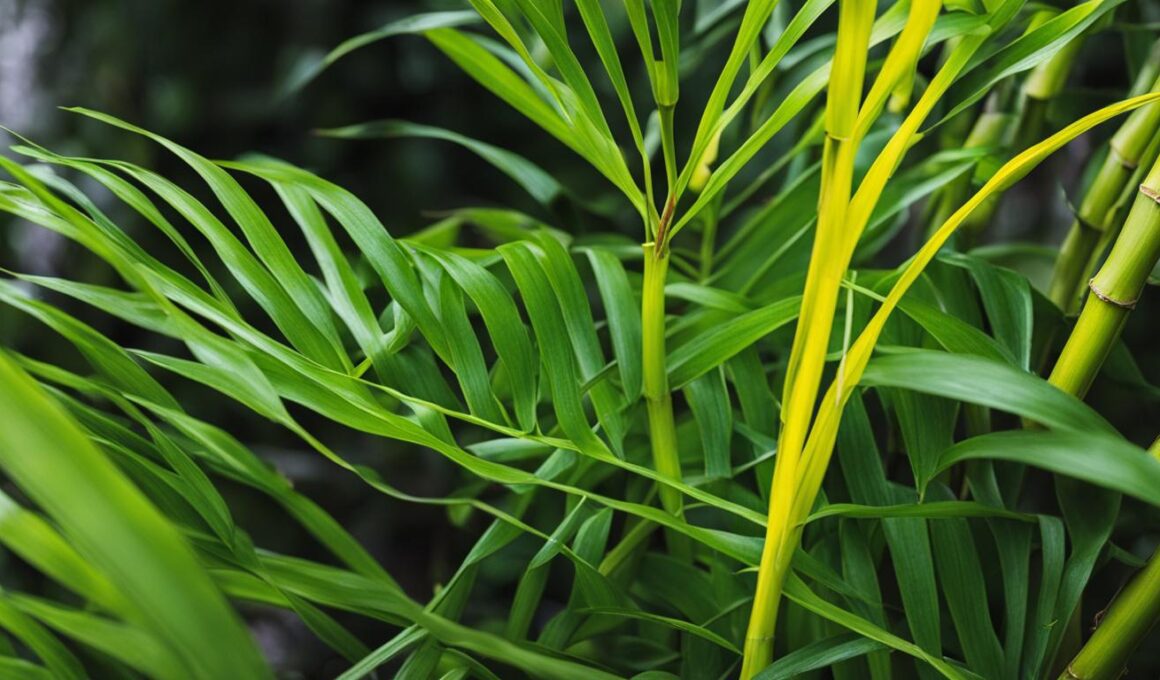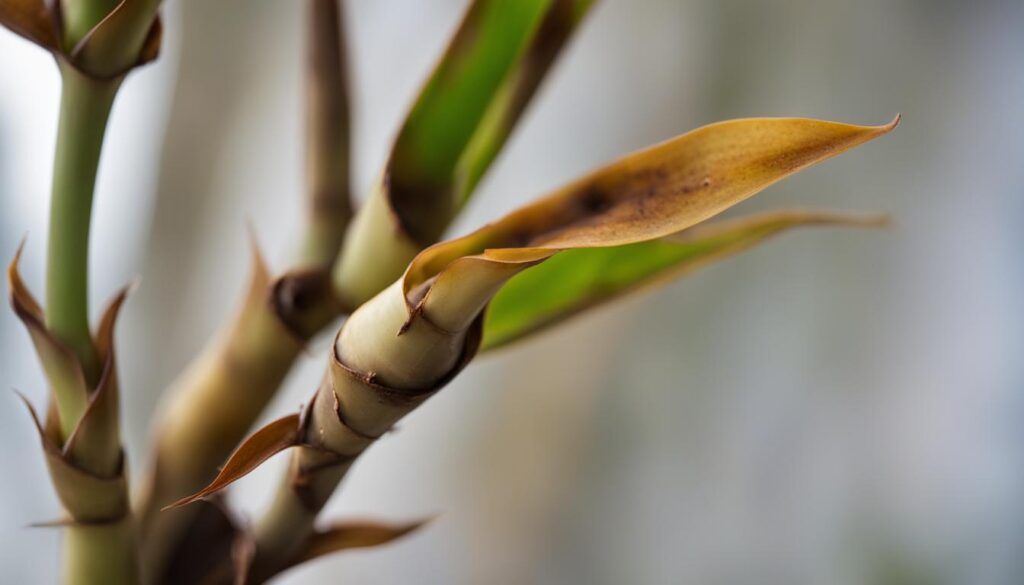If you’ve noticed your lucky bamboo plant’s leaves turning yellow, it’s important to understand the underlying causes to ensure the health and vitality of your plant. Lucky bamboo is a popular indoor plant known for its vibrant green foliage and beautiful presence. However, yellow leaves can be a sign of distress, indicating that something is amiss with your plant’s care.
There are several factors that can contribute to yellowing leaves in lucky bamboo plants. One common cause is improper watering. Whether your bamboo is potted in soil or placed in water, finding the right balance is crucial. Overwatering can lead to root rot, while underwatering can cause dryness and yellowing. It’s essential to water your lucky bamboo when the top 50% of the soil is dry, ensuring that you discard any excess water to prevent waterlogged conditions.
The quality of the water used can also affect the health of your lucky bamboo. Tap water often contains minerals and fluoride that can be harmful to sensitive plants. Consider using distilled or rainwater, or let tap water sit out overnight to allow some of the chemicals to evaporate before using it to water your bamboo.
Another factor to consider is the amount of light your lucky bamboo receives. Too much bright light or too little light can cause the leaves to turn yellow. Lucky bamboo prefers indirect bright light, so placing it near an east-facing window or a few feet back from a southern or western window can provide the ideal amount of light.
Over-fertilization can also lead to yellowing leaves in lucky bamboo. This plant requires very little fertilizer, so be cautious not to overdo it. Only fertilize once in the early spring and use a fertilizer specifically formulated for lucky bamboo or other houseplants.
Temperature fluctuations can stress your plant and contribute to yellowing leaves. Keep your lucky bamboo away from drafty windows or air vents to maintain consistent temperatures and avoid drastic fluctuations.
Lastly, if you notice new growth on your plant along with yellowing leaves, it’s likely a natural process of shedding old leaves to focus energy on new growth. Simply trim off the old leaves to promote healthy new growth and maintain the overall aesthetics of your lucky bamboo plant.
By understanding these factors and implementing proper care techniques, you can prevent and address yellowing leaves in your lucky bamboo, ensuring its continued health and beauty.
Common Causes of Yellowing Lucky Bamboo Leaves
If you notice that the leaves of your lucky bamboo are turning yellow, there are several potential causes to consider. Whether you have indoor bamboo or outdoor bamboo, understanding these causes can help you identify and address the problem.
- Pests: Lucky bamboo plants can be susceptible to pests like spider mites and aphids. These pests can infest the leaves and cause yellow spots to appear.
- Overwatering: One common cause of yellowing leaves is overwatering. If the bamboo is sitting in waterlogged soil, the roots can rot, leading to yellow leaves.
- Insufficient Light: Lucky bamboo thrives in bright but indirect sunlight. If it is not getting enough light, the leaves can turn yellow. Make sure to place your indoor bamboo in a location where it can receive adequate light.
- Wrong Environment: Factors like excessive sun exposure or low temperatures can stress the plant and cause yellowing leaves. Ensure that your bamboo is in a suitable environment that meets its specific needs.
To expand on the causes specific to outdoor bamboo, incorrect watering is a common culprit. Dry soil can cause the leaves to yellow and die, while overwatering can lead to root rot. Other factors, such as low soil nutrients, stressful growing situations (like excessive wind or pollution), and pests can contribute to yellowing outdoor bamboo leaves.
To help you visualize lucky bamboo plants with yellow leaves, take a look at the image below:
Now that you know some of the common causes of yellowing lucky bamboo leaves, you can take steps to address the issue and keep your plant healthy. In the next section, we’ll explore strategies for preventing and fixing yellowing leaves.
How to Prevent and Fix Yellowing Lucky Bamboo
To prevent yellowing leaves in your lucky bamboo plant, follow these care tips:
- Proper watering: Water your lucky bamboo correctly by only watering when the soil is dry. Avoid overwatering, as this can lead to root rot. If your lucky bamboo is in soil, water it when the top 50% of the soil is dry, making sure to discard any excess water. If it sits in soggy soil, it can lead to root rot. If your bamboo is in water, change the water weekly to prevent fungal and bacterial growth.
- Use clean water: The quality of water used can affect the health of your lucky bamboo. Tap water may contain minerals and fluoride that can negatively impact your plant. Consider using distilled or rainwater, or let tap water sit out overnight to allow some of the chemicals to evaporate.
- Provide the right amount of light: Lucky bamboo prefers bright, indirect light. Place it close to an east-facing window or a few feet back from a southern or western window to ensure it gets the ideal amount of light. Avoid placing it in direct sunlight or areas with low light levels.
- Be cautious with fertilization: Bamboo plants require very little fertilizer. Over-fertilizing can burn the roots and cause yellowing. Only fertilize your lucky bamboo once in the early spring using a good quality potting mix or soil that provides the necessary nutrients.
- Protect your bamboo: If growing outdoor bamboo, ensure that the soil is acidic, rich, and loamy. Shield the plant from stressful growing situations, such as excessive wind or pollution. Minimize pesticide use if it is affecting the health of your plant.
- Inspect for pests: Regularly inspect your bamboo plant for pests like spider mites and aphids. If you notice any infestations, take appropriate measures to eliminate them. This can help prevent yellow spots and discoloration on the leaves.
- Monitor temperature: Avoid sudden temperature fluctuations that can stress your lucky bamboo. Keep it away from drafty windows or air vents to ensure a stable environment for the plant.
- Trim yellowed leaves: If your lucky bamboo already has yellow leaves, trim off the damaged or yellowed leaves. This will promote new growth and help maintain the overall health of the plant.
Conclusion
In conclusion, taking proper care of your lucky bamboo is crucial for maintaining its health and preventing yellowing leaves. By understanding the causes of yellowing and implementing maintenance tips, you can keep your lucky bamboo vibrant and green. Remember to water your plant correctly, providing clean water and avoiding overwatering. Ensure that your lucky bamboo receives the right amount of bright, indirect light and protect it from temperature fluctuations and stressful conditions.
Avoid over-fertilization and use a good quality potting mix or soil to provide the necessary nutrients. Regularly trim off any yellowed or damaged leaves to promote new growth and maintain the overall health of your plant. By following these care tips and monitoring your lucky bamboo’s condition, you can enjoy a beautiful and thriving plant in your home or garden.
Remember to check the soil moisture and water accordingly, use clean water, choose the right light conditions, and protect your lucky bamboo from any potential stressors. With proper care and attention, your lucky bamboo will continue to bring beauty and serenity to your space. Happy gardening!
Is Yellow Fungus in Soil Affecting Your Lucky Bamboo’s Health?
If you’ve noticed yellow fungus in your soil, your lucky bamboo may be at risk. However, there are effective remedies for yellow fungus that can help restore your plant’s health. Consider repotting your bamboo, adjusting watering habits, and using fungicide to combat the issue and promote growth.









